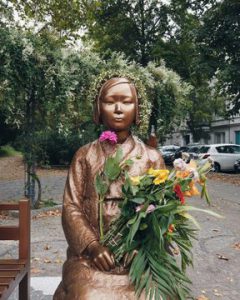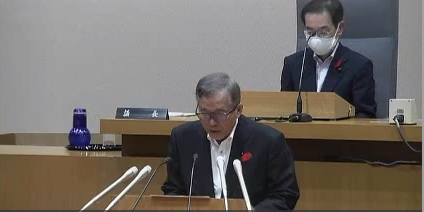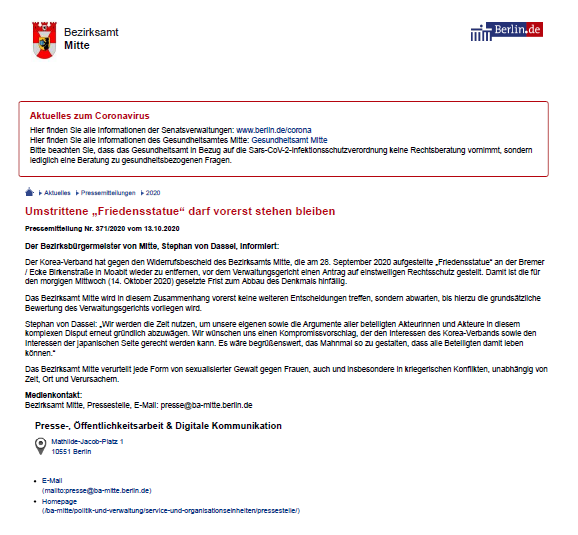
ベルリン慰安婦支援団体「AG „TROSTFRAUEN“」の慰安婦像を支持する公開書簡
平和の像はそのままに!ドイツ平和像連合の公開書簡
The Statue of Peace must stay! Open letter of the coalition for the Statue of Peace in Germany
Die Friedensstatue muss bleiben! Offener Brief des Bündnisses für die Friedensstatue in Deutschland
http://trostfrauen.de/offener-brief-friedensstatue/
の賛同者リストから 大学教授、大学関係、政治家、団体などを以下にピックアップしました。
**********************************************************
【 大学教授 】
Prof. Dr. Steffi Richter, Ostasiatisches Institut/Japanologie, Universität Leipzig
Prof. Dr. Ilse Lenz
Prof. Dr. Bernd Ladwig, Freie Universität Berlin
Prof. Dr. Trevor Evans, Hochschule für Wirtschaft und Recht Berlin
Prof. Dr. Markus Wissen, Hochschule für Wirtschaft und Recht Berlin
Prof. Dr. Eun-Jeung Lee, Freie Universität Berlin
Prof. Dr. Frieder Otto Wolf, Institut für Philosophie, Freie Universität Berlin
Prof. Dr. Martina Metzger, Hochschule für Wirtshaft und Recht (HWR) Berlin
Prof. Gabriele Kaczmarczyk, Charite
Prof. Dr. Jeong-hee Lee-Kalisch, Ostasiatische Kunstgeschichte, Freie Universität Berlin
Prof. Dr. Andreas Lob-Hüdepohl, Berliner Institut für christliche Ethik und Politik
Prof. Dr. Misun Han-Broich, Ev. Hochschule Tabor in Marburg und Berlin
Prof. Dr. Melanie Jaeger-Erben, Technische Universität Berlin
Prof. Dr. Sigrid Betzelt, Hochschule für Wirtschaft und Recht Berlin
Prof. Dr. Matthias Middell, Universität Leipzig
Professor Dr. Robert Kappel, Universität Leipzig
Prof. Dr. Isabell Lorey,,Kunsthochschule für Medien Köln
Prof. Dr. Felix Wemheuer, Universität zu Köln
Prof. Dr. Christoph Antweiler, Universität Bonn
Prof. Dr. Hartwig Hummel, Heinrich Heine Universität Düsseldorf
Prof. Dr. Hannes B. Mosler, Universität Duisburg Essen
Prof. em. Dr. Winfried Flüchter, Universität Duisburg-Essen, Institut für Ostasienwissenschaften(主戦場上映)
Prof. Dr. Dr. Sigrid Graumann, Evangelische Hochschule Bochum
Prof. Dr. Matthias Rögner, Ruhr-Universität Bochum
Prof. Dr. Hanns Wienold, Universität Münster
Prof. Dr. Helma Lutz, Goethe Universität Frankfurt
Prof. Dr. Yonson Ahn, Goethe Universität Frankfurt
Apl. Prof. Dr. Alex Demirovic, Goethe Universität
Ass. Prof. Dr. Stefanie Hürtgen, Universität Salzburg und Frankfurter Institut für Sozialforschung
Prof. Dr. Susanne Buckley-Zistel, Zentrum für Konfliktforschung, Philipps-Universität Marburg
Prof. Dr. Sonja Buckel, Politikwissenschaft Universität Kassel
Prof. Dr., Klaus Antoni, Universität Tübingen, AOI – Japanologie
Prof.i.R. Dr. Susanne Schunter -Kleemann, Hochschule Bremen
Prof. Dr. Timothy Williams, Staats- und Sozialwissenschaften, Universität der Bundeswehr München
Prof. Dr. Aleida Assmann, Universität Konstanz
Prof. Rüdiger Lautmann, Universität Bremen
Prof. Dr. Judith Beyer, Universität Konstanz
Prof. Dr. Helen Schwenken, Universität Osnabrück, Institut für Migrationsforschung und Interkulturelle Studien (IMIS)
Prof. Dr. Wolfgang Methling, Wiss. Beirat Rosa-Luxemburg-Stiftung
Prof. Dr. Simone Müller, Universität Zürich
Prof. Dr. Philipp Sarasin, Universität Zürich
Prof. Dr. Svenja Goltermann, Universität Zürich
Prof. Dr. Ulrich Brand, Universität Wien
Univ.-Prof. i.R. Dr. Dieter Segert, Universität Wien
Prof.Dr. Wolfram Manzenreiter, Universität Wien
Prof. Dr. Daniel Bendix, Theologische Hochschule Friedensau
【 大学関係者 】
Dorothea Mladenova, Ostasiatisches Institut/Japanologie, Universität Leipzig(反日研究)
Dr. habil. Maria Schetelich, Universität Leipzig
Anna Weber, externe Lehrbeauftragte, Hochschule für Wirtschaft und Recht Berlin
Annabell Führes, Freie Universität Berlin
Dr. Teresa Orozco, Freie Universität Berlin
PD Dr. Susanne Lettow, Freie Universität Berlin
PD Dr. Sabine Grenz, Humboldt-Universität
Marianne Kriszio-Tadrus, Humboldt Universität, Zentrum für transdisziplinäre Geschlechterstudien
Daniel Döbbeler, Universität zu Köln
Priv.-Doz. Dr. Detlev Taranczewski, Japanologie u. Koreanistik, Universität Bonn
Yoko Taranczewski
Dr. Nadeschda Bachem, Universität Bonn
Jakub Poprawa, M.A., Ruhr-Universität Bochum
Jutta Teuwsen, TU Dortmund
Dr. Hee Kyoung Chang, Universität Duisburg-Essen
PD Dr. Alexandra Scheele, Universität Bielefeld
Allgemeiner Studierendenausschuss (AStA), Goethe-Universität Frankfurt am Main(慰安婦像)
Jenny Simon, Dipl. Pol., Universität Kassel
Philipp Schultheiss, Universität Marburg
Uwe Bittlingmayer, Pädagogische Hochschule Freiburg
Dr. Michael Wachutka, Universität Tübingen, AOI – Japanologie
Dr. Susanna Eismann, Universität Trier
Dr.in Karoline Feyertag, mdw – Universität für Musik und darstellende Kunst Wien
Dr. Mariama Diagne, mdw Universität für Musik und darstellende Kunst Wien
Ingrid Schacherl, Akademie der bildenden Künste Wien
Dr. Barbara Rothmüller, Sigmund Freud Universität Wien
Dr. Corinna Oesch, Universität Wien
Dr. Andreas Exner, RCE Graz-Styria, Universität Graz
Dr. Eri Park, University College Roosevelt, Utrecht University
Dr. Martin Meyer, Universität Vechta
Hyun-Woo Cho, M.A. Japanologie
【 政治家 】
Dr. Axel Troost, stellvertretender Parteivorsitzender DIE LINKE
Fabian Dickmeis, Sprecher LAG Kultur Die Linke. Berlin
Armin Schäfer, GewerkschaftsGrün Berlin
Dr. Frithjof Schmidt, Fraktion Bündnis 90/ Die Grünen
Jorgos Gurglis, Bürgermeusteramt Olympia Elis Grichenland
Dr. Frithjof Schmidt, MdB, Deutscher Bundestag
【 教会関係 】
Bodo Walther, Diakon/Sozialtherapeut i. R., Arbeitskreis Japan in der Ev.-luth.Landeskirche in Braunschweig
Hartmut Dreier, evangelischer Pastor
【 ドイツ東アジアミッション 】
Paul Schneiss, Deutsche Ostasienmission
Lutz Drescher, Deutsche Ostasienmission (DOAM)
Heidrun Perron, DOAM Deutsche Ostasienmission
Dr. Carola Hoffmann-Richter, Deutsche Ostasienmission
Stephan Graetsch Diakon, Korea Arbeitskreis Berliner Missionswerk, Vorstandsmitglied in der Deutschen Ostasienmission
Eun Pyo Lee, Koreanische Evangelische Kirchengemeinde Zukero in Düsseldorf(韓国系)
Minyoung Kang, Koreanische Evangelische Kirchengemeinde Rhein-Main(慰安婦像)
Martin Röttger, Pfarrer, Evangelische Kirchengemeinde Bochum Wiemelhausen(慰安婦展)
【 他団体 】
Dr. Christa Wichterich, Stiftung Asienhaus
Dr. Wolfram Schaffar, Stiftung Asienhaus, Köln
Dr. Monika Schlicher, Stiftung Asienhaus
Dr. Uwe Hoering, Stiftung Asienhaus
Jinhyang Moeck, Korea Verband Trostfaun AG
Daniel Seyde, Deutsch-Japanisches Friedensforum(独日平和フォーラム)











